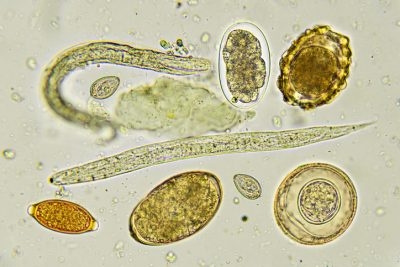
Parasites and Poverty in the South
By Stan Deresinski, MD, FIDSA
Synopsis: Parasite contamination of soil remains prevalent in some areas of the southern United States.
Source: Crudo Blackburn C, Yan SM, McCormick D, et al. Parasitic contamination of soil in the southern United States. Am J Trop Med Hyg 2024;111:506-514.
Crudo Blackburn and colleagues investigated soil contamination with parasites in the southern United States. They collected soil samples from five communities in Alabama, Louisiana, Texas, Mississippi, and South Carolina. The communities are in the highest quintile for poverty rate within the United States. Only the Texas community was considered urban.
Approximately 100 samples were collected from four to six sites in each community from public parks and private residences. Deoxyribonucleic acid (DNA) in the samples was concentrated and extracted, followed by performing real-time quantitative polymerase chain reaction (qPCR).
Parasite DNA was detected in the following proportion of samples: Blastocystis spp. (19.03%), Toxocara cati (6.01%), Toxocara canis (3.61%), Strongyloides stercoralis (2.00%), Trichuris trichiura (1.80%), Ancylostoma duodenale (1.42%), Giardia intestinalis (1.40%), Cryptosporidium spp. (1.01%), Entamoeba histolytica (0.20%), and Necator americanus (0.20%). Ascaris lumbricoides was not detected. Parasite contamination rates varied by community, ranging from 6.93% in south Texas to 46.99% in the western Mississippi community, with intermediate values in southwestern South Carolina (27.93%), northeastern Louisiana (27.93%), and southwestern Alabama (39.62%).
Poverty rates were high in these communities, ranging from 23.05% in south Texas (median household income $47,278) to 50.57% in northeastern Louisiana (median household income $17,801). The community in western Mississippi, which had the highest parasite contamination rate, also had one of the highest poverty rates (49.60%).
Commentary
In 1902, Charles Stiles reported on his work examining the high prevalence of hookworm (Necator americanus) in the southern United States to a conference of the Sanitary Commission.1 Seven years later, John D. Rockefeller, Sr., provided $1 million to establish the Rockefeller Sanitary Commission for the Eradication of Hookworm Disease with Stiles, with the ultimate aim of eradicating hookworm in the southern United States, where it was estimated that approximately 40% of the population was infected, an estimate that Sir William Osler, however, strongly believed was markedly exaggerated. While the commission greatly reduced the hookworm problem, it did not totally eliminate it, as can be seen by the continued presence of N. americanus in soil samples, albeit at a very low prevalence. Control of hookworm, which disproportionately affected the poorest members of the population, led to significant regional economic benefit. The current high prevalence of soil parasites, particularly in association with populations affected by poverty, indicates there is a long way to go in the region.
Stan Deresinski, MD, is Clinical Professor of Medicine, Stanford University.
Reference
- Elman C, McGuire RA, Wittman B. Extending public health: The Rockefeller Sanitary Commission and hookworm in the American South. Am J Public Health 2014;104:47-58.
Parasite contamination of soil remains prevalent in some areas of the southern United States.
Subscribe Now for Access
You have reached your article limit for the month. We hope you found our articles both enjoyable and insightful. For information on new subscriptions, product trials, alternative billing arrangements or group and site discounts please call 800-688-2421. We look forward to having you as a long-term member of the Relias Media community.
